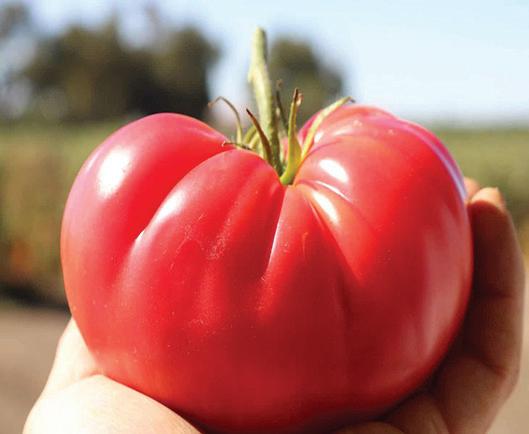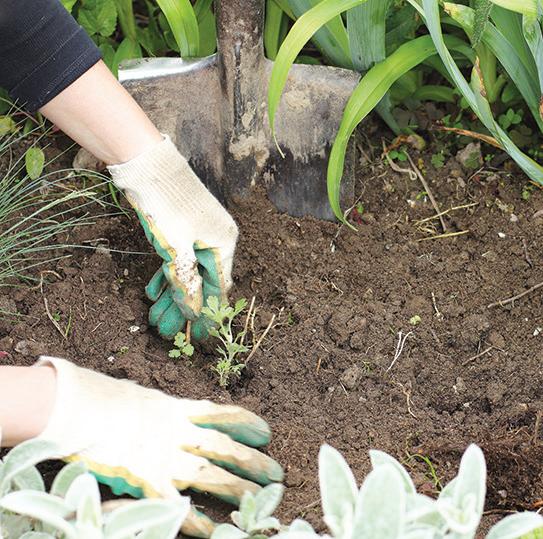
4 minute read
TIDEWATER GARDENING

by K. Marc Teffeau, Ph.D.
April Projects
Spring seems to have arrived a little early this year. Not that the winter was so bad, but it’s nice to enjoy warmer temperatures and longer daylight hours. The daffodils and other spring-flowering bulbs flowered out early. Now, they need some attention. Cut the spent flower stalks back to the ground on daffodils, hyacinths and other spring bulbs as the flowers fade.
Don’t cut the foliage until it dies down naturally, however. I know this frustrates some gardeners because the foliage can look messy. You may see some bulb foliage tied in a bunch to neaten the appearance, but this practice defeats the purpose of leaving the foliage in the first place.
As I have mentioned in past columns, the leaves are necessary to produce the nutrients needed for strong bulbs capable of reflowering. I have had more than one gardener tell me this is why they don’t plant bulbs. Planting annuals in the same flower bed as the bulbs is a good way to cover the bulb foliage while allowing the leaves to do the work of nutrient replenishment. To keep the planting going, you can fertilize bulbs upon the emergence of foliage with a 10-10-10 fertilizer, using a rate of 1 pound per 100 square feet. Repeat the application after the bulbs have bloomed.
Observe your daffodil and other spring bulbs while in bloom to be sure they have not been shaded by the new growth of other tree or shrub plantings. If they have, you may need to move your bulbs to a new, sunny location or prune back the plantings. Label the clumps of daffodils that are too crowded, as overcrowding inhibits blooming, then dig up and separate them in July. Store in a cool, dry location and replant in fall. I find the mesh insect problems. If you plant the seed too early, it may just rot in the soil due to cold soil conditions. Plants started later from the same seed packets will soon catch up and will often surpass those that had to struggle through the cold ground.






Tidewater Gardening bags that oranges are sold in at the grocery store to be good storage bags. They allow air to circulate around the bulbs, which reduces rotting.
April’s warmer weather may tempt us to rush the planting season, but remember that we can still get a frost into May that can damage newly planted transplants. It’s not wise to plant tomato plants when the first 60-degree day arrives. If you try to get too much of a jump on the weather by setting out tender plants and seeds now, you are in for disappointment.
Even when frost isn’t a factor, warm soil is necessary for the good growth of many plants. For most conventional row gardeners, little is gained by seeding snap beans, corn, squash and cucumbers before May 1, or lima beans, cantaloupes and watermelons before May 15. Even if they do sprout, growth will be slow, seedling vigor will be reduced and the plants will be more susceptible to disease and


The same applies to transplants of warm-season crops like tomatoes, peppers and eggplants. Don’t rush the season by putting them in too early. Their roots will languish in cold soil, and the air temperature has to get above 65 degrees for them to set fruit. If you are a raised bed gardener, you have a little advantage in getting certain crops in earlier. Soil tends to warm up more quickly in raised beds.
The use of a floating fabric like Re-May will help with heat retention in soil. In normal years, it can provide a 10- to 14-day start on the production of broccoli, cabbage and summer squash. In addition, the fabric will give you some earlyseason insect control if you handle it carefully and keep the crops covered until it gets too warm during the day to do so.
If you are looking to grow some different vegetable cultivars this year, there are two All-American Selections (AAS) (all-americaselections.org) that you might want to try. An AAS 2023 winner in the winter squash cultivars is Squash kabocha Sweet Jade F1. According to AAS, this “cute, single-servingsized squash is the perfect addition to your garden for a fall harvest. Sweet Jade proved itself in the AAS Trials with its high yields and good holding capability which is great news for both home gardeners and growers."

Each fruit is between 1–2 pounds and can be used for single servings of squash, as an edible soup bowl, or in any number of Asian-style dishes where a sweet, earthy nutritious squash is typically used. Sweet Jade’s deep orange flesh is dry yet sweet and very flavorful whether roasted, baked, or pureed.” I do not grow winter squash in my small garden, but I might try this squash on a trellis, as the fruits are small. Although there are thousands of tomato cultivars, if you like pink tomatoes, you might try an AAS 2022 winner, Tomato Pink Delicious. AAS marketing comments state, “With ‘Delicious’ in its name, it has to be good! This early maturing tomato supports the trend of having an heirloom look, flavor, and texture with hybrid disease resistance and improved germination meaning it is much easier for home gardeners to grow.

"When grown next to the comparisons, this variety is definitely earlier with a higher yield and a very uniform fruit size. The beautiful big fruits do not crack as much. What really sets this variety apart is the excellent flavor and a high Brix for a sweeter than normal pink tomato.” This tomato is an upright vine, climbing to 6 feet, and has a beefsteak fruit shape. The AAS website lists where you can purchase seeds for Squash kabocha Sweet Jade F1 and Tomato Pink Delicious.
The perennials will be poking their heads out of their beds in April as the soil warms up. Chrysanthemums are now popping up in the flowerbed. Lift, divide and replant chrysanthemums as soon as new shoots appear. Each rooted shoot or clump will develop into a fine plant for late-summer bloom.
Thicken the plant by pinching out the top when it is about 4 inches high. You can also take chrysanthemum cuttings now through mid-June for flowers in fall and winter in the greenhouse.
Now is a good time to dig and divide fall-flowering perennials that have multiplied and overfilled the flowerbed. That’s one of the nice things about perennials: after they become established, all you have to do is divide them instead of buying additional plants. Check with your gardening friends. They may have dug extra fall-flowering perennials, and you can do a plant swap.
Flats of annual flower transplants are now at local garden centers. When purchasing bedding annuals this spring, choose properly grown plants with good color. Buy plants with well-developed root systems that are vigorous but not too large for their pots. Check












